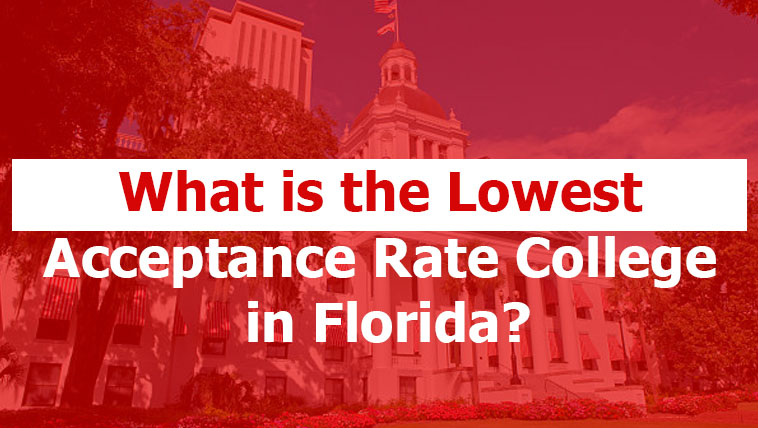When it comes to Florida colleges, many students ask: which school is the hardest to get into? The answer is clear—the University of Miami holds the lowest acceptance rate in Florida, admitting only around 19% of applicants. This makes it the most selective institution in the state, surpassing even the University of Florida and Florida State University in terms of competitiveness.

If you’re planning to apply, you’ll need strong academics, impressive extracurriculars, and a compelling application to stand out. Below, we break down everything you need to know about the University of Miami’s selectivity, along with comparisons to other competitive Florida colleges.
Lowest Acceptance Rate Colleges in Florida
| University / College | Acceptance Rate | Location | Key Highlights | Official Website |
|---|---|---|---|---|
| University of Miami (UM) | ~19% | Coral Gables, FL | Prestigious private research university, strong medical and business programs, diverse campus life | miami.edu |
| University of Florida (UF) | ~23% | Gainesville, FL | Flagship public university, top-ranked academics, extensive research funding, strong athletics | ufl.edu |
| Florida State University (FSU) | ~25% | Tallahassee, FL | Renowned for arts, business, and research; vibrant campus traditions | fsu.edu |
| Florida International University (FIU) | ~33% | Miami, FL | Large international student body, strong global focus, business and hospitality programs | fiu.edu |
| University of Central Florida (UCF) | ~36% | Orlando, FL | One of the largest U.S. universities, tech partnerships, research in engineering and space | ucf.edu |
| Florida Atlantic University (FAU) | ~78% | Boca Raton, FL | Growing research presence, affordable tuition, access to South Florida’s job market | fau.edu |
Note: Acceptance rates vary slightly each year depending on applications and available spots. The figures above reflect the most recent data available from admissions reports.
1. University of Miami – The Most Selective in Florida
The University of Miami (UM), located in Coral Gables, is well-known for its rigorous admissions process. With an acceptance rate hovering around 19%, it consistently ranks as the most selective private university in Florida. Students from across the U.S. and around the globe compete for a limited number of seats, making UM the toughest school in Florida to gain admission into.
One reason for this low acceptance rate is the sheer volume of applications. The university attracts over 40,000 applicants annually, but only a fraction make it through. Its strong reputation in fields like business, medicine, marine science, and law makes it highly desirable, driving up the competition.
Academically, admitted students typically boast SAT scores between 1300–1460 or ACT scores between 30–33. Beyond test scores, the admissions office also places great weight on essays, recommendation letters, and extracurricular involvement. A well-rounded student profile often makes the difference.
The university also attracts students with its vibrant campus life, located near Miami’s cultural and financial hub. From athletics to arts, students experience a lively mix of academics and extracurricular opportunities. This location advantage boosts its appeal and keeps the acceptance rate low.
In short, if you’re aiming for UM, you’ll need much more than good grades. The holistic review ensures that only students with academic excellence, leadership qualities, and personal growth potential earn a spot.
2. University of Florida – A Close Second
The University of Florida (UF) in Gainesville is another highly competitive institution, though its acceptance rate is slightly higher than UM’s. At around 23–30%, UF is considered one of the most selective public universities in the nation. It routinely ranks among the Top 5 public universities in the U.S.
Part of UF’s selectivity comes from its massive applicant pool. Each year, tens of thousands of students apply, hoping to take advantage of its low in-state tuition and world-class academic programs. Popular majors include engineering, health sciences, and business, attracting some of the best and brightest minds in Florida and beyond.
Admitted students typically present a high school GPA near 4.4 (weighted) and standardized test scores in the top 10–15% nationally. UF prides itself on creating an academically rigorous environment where only the strongest students thrive.
In addition to academics, UF offers research opportunities, a competitive athletic scene (think Gators football), and one of the largest university alumni networks in the country. This combination makes UF a dream school for many, further tightening the admissions bottleneck.
While not quite as selective as UM, the University of Florida still represents one of the toughest challenges for students applying to college in Florida.
3. Florida State University – Selective but Accessible
Florida State University (FSU) in Tallahassee is another top contender for competitive admissions. Its acceptance rate sits around 25–33%, making it highly selective but slightly more accessible compared to UM and UF. Students looking for a strong academic program with a slightly higher chance of admission often consider FSU.
FSU is particularly attractive to students pursuing majors in the arts, business, political science, and film. In fact, its College of Motion Picture Arts is consistently ranked among the best in the nation. This draws applicants from across the world, increasing the school’s prestige.
The average admitted student typically scores between 1220–1350 on the SAT or 27–30 on the ACT, paired with a GPA above 4.0 (weighted). These numbers highlight the competitiveness but also show that FSU casts a slightly wider net compared to UM and UF.
Beyond academics, FSU is renowned for its student life and athletics. From the Seminoles football program to a thriving Greek life, it offers a traditional college experience alongside strong academics.
FSU’s slightly higher acceptance rate makes it a good option for students who may not meet UM’s or UF’s strictest standards but still want a rigorous and prestigious education in Florida.
4. University of Central Florida – Large but Competitive
With more than 68,000 students, the University of Central Florida (UCF) in Orlando is the largest university in the nation by enrollment. Despite its size, UCF maintains competitive admissions, with an acceptance rate of around 36–45%.
UCF’s appeal lies in its location in Orlando, close to industries such as tourism, aerospace, and technology. This creates unmatched internship and career opportunities for students. Many applicants are drawn to UCF because of its strength in engineering, computer science, hospitality management, and business programs.
Though UCF admits more students than UM or UF, competition remains tough due to its reputation and size. Admitted students generally present SAT scores of 1170–1340 and GPAs above 3.8. This shows that UCF still seeks academically strong candidates.
The university’s vibrant campus culture also attracts thousands of students each year. From cutting-edge research centers to a highly spirited athletic program, UCF combines academic rigor with a fun, opportunity-rich environment.
While it may not be the hardest school to get into in Florida, UCF’s growing prestige means it remains a competitive choice for international and local applicants alike.
5. Other Selective Colleges in Florida
Beyond the big four, several other Florida institutions also maintain competitive admissions, though their acceptance rates are slightly higher. Schools like Florida International University (FIU), University of South Florida (USF), and Rollins College attract strong applicants and continue to rise in academic reputation.
Rollins College, a private liberal arts school in Winter Park, admits roughly 50% of applicants. While less selective than UM, its small class sizes and personalized education make it appealing for students seeking a close-knit learning environment.
FIU and USF, both large public research universities, admit around 50–60% of applicants. While more accessible, they still offer high academic standards and opportunities in fields such as business, medicine, and international relations.
These schools represent excellent opportunities for students who want quality education without the razor-thin acceptance rates of UM or UF. They provide balance—rigorous academics with slightly more attainable admissions.
Overall, Florida offers a diverse range of college options, from highly selective institutions to more accessible universities, catering to different student needs.
Final Thought
So, what is the lowest acceptance rate college in Florida? The answer is clear: the University of Miami, with an acceptance rate around 19%. It stands as the toughest school to get into in Florida, followed closely by the University of Florida and Florida State University. Students hoping to join UM need more than stellar grades—they need a strong all-around application to stand out.
At the same time, other competitive schools like UCF, FIU, USF, and Rollins College give students alternative pathways to a top-tier Florida education. Whether you want the challenge of UM or a more balanced admission process, Florida offers plenty of opportunities for ambitious students.
Also Check:
Which College in Florida have a 100% Acceptance Rate? Here are the Top 10
Top 10 Ongoing Fully Funded U.S. Fellowships 2025 (Aug–Sep 2025 Deadlines)
